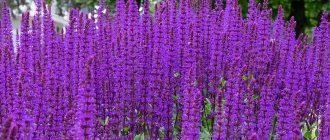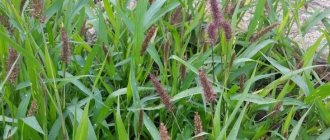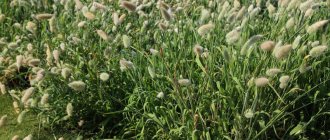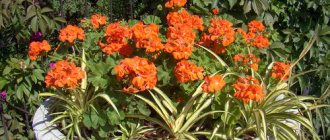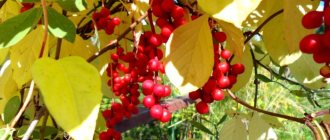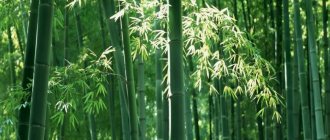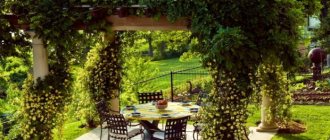Indoors, in a pot, dwarf euonymus is no higher than 30 cm in height. The leaves are oblong, 4 cm long. The sides of the leaf are slightly bent down, and the edge is pointed.
The upper part of the leaf is bright green, but the lower part is bluish. The flowers are small, single, red-brown in color. Occasionally, flowers can be collected in small inflorescences 2 cm long, containing 2-3 flowers.
Important! You should be aware that fruits are poisonous to humans ! In summer, the fruits (in the form of a capsule) are pale green, but by autumn they begin to turn red until they acquire a burgundy hue. Very beautiful, but poisonous. If there are small children in the house, then it would be best to pick the fruits from the bush in advance.
Kinds
Let's look at the main varieties of euonymus:
- unique winged;
- beautiful European;
- unpretentious warty;
- Japanese.
Botanical description of the plant
The photo and description of the shrub under the general name euonymus sometimes contain contradictory data, but these are not mistakes of the authors, but a confusion of species characteristics, made under the influence of the misconception that all plants under this name certainly have similar characteristics.
In reality, plants called euonymus (popularly known as wolf's bast, blind hen, goatweed or sourweed) may include the following characteristics:
- vine, shrub or small tree;
- woody plant, deciduous or evergreen;
- a shrub with round or tetrahedral shoots;
- flowers are pale green or slightly brownish;
- inflorescences in the form of a corymb or brush;
- fruit winged or with thorns;
- seeds are red, black, brown, covered with an apimentum;
- This four-part capsule can, when ripe, acquire beautiful shades of yellow, purple, red or pink in different species.
Even in the characteristic features by which researchers distinguished genera and species, discrepancies can easily be found in nature. There are species with 4 or 5 sepals, consisting of petals, stamens, a pistil with 3 or 5 lobes, a capsule, which is said to usually consist of 4 sections. But there are certain species in which this rule is not observed.
.
Photo
You can evaluate the appearance of the dwarf euonymus using our photo gallery:
Winter hardiness
Dwarf euonymus has high winter hardiness (zone 4). Adult plants do not need shelter during the cold season. This does not apply to shrubs that are less than 5 years old. For the winter, they need to be wrapped in a fabric that allows air to pass through well, such as cotton. To retain heat better, you can also cover the plant with burlap.
Plant care
Despite the large number of species of euonymus, it is the dwarf Japanese euonymus that has become popular among gardeners. The fact is that the plant has extremely low requirements for lighting and air humidity .
The air in the room may be relatively dry, and the pot with the plant may be in partial shade. However, in warm weather, the dwarf euonymus should be taken out into the fresh air from time to time and ventilated.
It should be remembered that euonymus does not like bright sunlight . If direct sunlight hits the leaves of a plant, over time they begin to turn yellow or become covered with brown spots.
For growing dwarf euonymus, the optimal temperature is +18-20 degrees . But the plant tolerates a decrease or increase in temperature easily.
In the warm season , when the air temperature is very high, the euonymus should be watered and sprayed with clean water more often .
You should know! If in the winter season the bush is located near heat sources, then the probability of shedding leaves is very high. To prevent this from happening, dwarf euonymus is sprayed or washed with leaves.
If the plant is planted in the ground, then it is protected for the winter by covering it with any branches of coniferous trees.
Dwarf euonymus on the site
The dwarf euonymus, thanks to its creeping shape, will look great on an alpine hill, in a rock garden, and will wonderfully decorate slopes and slopes. It goes well with its brother - Fortune's euonymus.
Can be used for landscaping around tree trunks, in mixborders and various compositions.
This is one of the shade-loving types of euonymus, so it can be used in landscaping shady areas of the garden.
Planting and caring for dwarf euonymus does not require much effort. By planting such a shrub in your garden, you will help preserve an endangered species. And in gratitude you will receive a magnificent rich green carpet, which will be very decorative all year round and rival the beauty of the most exquisite grass lawn.
Watering
In summer, euonymus should be watered abundantly . But don't fill it up!
It is very important to organize good drainage at the stage of planting the shrub in a pot so that water does not stagnate at its roots.
The lower the air temperature, the less water is required.
In winter, watering should be moderate. But the soil around the plant should always be moist !
For irrigation, only settled water should be used. The water should stand for at least a day.
Despite the fact that the plant is not picky about humidity, dwarf euonymus should be sprayed regularly. This definitely won’t make things worse, and pests are removed very effectively with this treatment of the bush.
Varieties of euonymus for the street with photos and descriptions
From such plants you can create amazing landscape compositions in Japanese, French, English styles and rustic rosewoods. These varieties of shrubs are gas-resistant, so they are ideal for beautifying the city.
Fortune's euonymus . An evergreen creeping shrub, reaching a maximum height of 60 m and a length of up to 3 m. This evergreen plant comes from China. Fortune's stems are in contact with the ground, thanks to which the bush is able to cling to various supports. The buds are green or white at peak ripeness. The fruits are bright yellow in color, but they are poisonous, like all of the Euonymus family. This bright, variegated evergreen plant loves moist, fertile soil. Withstands haircuts very well. Suitable for landscaping parks, gardens, squares.
Euonymus Winged . The natural distribution zone of this shrub is Korea, China, Japan. A low branched shrub, Euonymus Winged, does not grow above 1 m in height and 2-3 m in diameter. The plant changes its color from bright green to fantastic burgundy in autumn. Blooms with bright yellow flowers. In autumn and winter, this variety of shrub bears bright, poisonous orange or burgundy-red berries. Usually the colored boxes hang on the bush until February, then they crack, exposing the orange seeds. The bushes tolerate well-drained soils with varying pH levels. They decorate rocky hills and borders, since this variety of euonymus can be trimmed.
Euonymus dwarf . The distribution area of the shrub is quite extensive - from Europe to Asia. The dwarf euonymus is listed in the Red Book as it is an endangered species. Under natural conditions, the shrub has practically lost its ability to reproduce. The height of a dwarf shrub usually does not reach 1 m, and the width is 1-2 m. The foliage is dense, leathery, elongated at the edges, with small teeth. The leaves are bright green above and bluish below. The flowers are brownish-light green. The fruits of the bush are flattened, yellow-green, sometimes with a pinkish tint. Euonymus dwarf is frost-resistant and easy to care for, so it can be used to landscape city park recreation areas, plant near buildings, and improve borders.
European euonymus . The RedCascade bush is considered one of the best shrubs for decorating the street in the autumn-winter period. European euonymus, or Bruslina, will help transform any area, transforming a nondescript lawn into an autumn red-pink landscape. Under the weight of the fruits in November, this bush takes on a weeping shape. The RedCascade shrub at its peak reaches 3-4 m in height and 2-3 m in width. In summer, Bruslina's foliage looks discreetly green, but in autumn the bush changes significantly and becomes crimson-red. The plant takes root well in bright sun and partial shade and does not like drought. This euonymus is resistant to exhaust and smoke, so it can be used to decorate city streets.
Euonymus Maak . This plant is found in deciduous forests, river and lake valleys, as well as in sandy loam areas of China, the Far East and Siberia. This euonymus plant grows up to 10 m. The leaves of the Maaka bush are large, smooth, ovate, with finely serrated edges. The buds are white and light green, collected in semi-shaped inflorescences. Maaka blooms only 4 years after planting in the ground. The plant is light-loving, cold- and drought-resistant.
Euonymus warty . In its natural environment, this shrub grows in the forests of Eurasia. Euonymus warty is considered one of the largest trees of its species. Its height is usually at least 4 m. In the wild, the bushes grow up to 10 m. The foliage of this euonymus is greenish, epileptically pointed, with denticles along the edges. By September, the leaves begin to take on a bright orange hue. The bush may not shed its leaves for a long time, and the flowering period occurs in the spring. The flowers are collected in racemes, where there can be up to 10 buds. The color of the petals is greenish-brown with purple splashes. The shrub tolerates cold winters well. Euonymus is drought-resistant, but you need to constantly maintain soil moisture.
Euonymus Fortune
Top dressing
In principle, additional feeding is not required . However, it would not be amiss to feed the plant with complex mineral fertilizers in the spring and summer. This is not required more than once a month.
Which fertilizers should be used depends on the activity of the plant. The dwarf Japanese euonymus is known to have two growth waves . The fact that the growth period is over is indicated by the appearance of buds (cones) at the top of each shoot.
And vice versa, when these buds begin to open and new leaves are formed, another wave of shrub growth is expected.
So, at the moment when activity is just beginning, you should feed the plant with nitrogen fertilizers. In the middle of the period, you can use complex fertilizers , and at the moment when the buds are formed - phosphorus-potassium fertilizers .
Is it possible to keep Euonymus at home: signs and superstitions
Euonymus not so long ago became known as a houseplant and spread around the world (previously it was popular only in Asian countries - China, Japan, Korea - as an element of landscape design), so it has not yet acquired signs and superstitions, after all, for this it takes a certain amount of time. In Asian countries, euonymus was most often grown outside, outside the home, and there were no special rules associated specifically with euonymus: general rules for arranging plants according to Feng Shui were used, not related to a specific genus of plants.
But it is known that from Latin the name “euonymus” is translated as “glorious, good.” It is also sometimes called pseudo-laurel, and laurel is associated with the victories and successes of Roman commanders, who were crowned with a laurel wreath for great achievements. Therefore, it can be assumed that the euonymus has warm energy, it attracts good luck into the house and protects its owners from troubles. Or, at least, it just pleases with bright greenery.
There are several legends about how the euonymus appeared.
According to the first, it appeared thanks to the ancient Greek goddess of plants, Flora. One day she was walking through the forest, and suddenly she lost her earring and pendant. The goddess became angry at the wayward decorations and ordered them to become poisonous plants. This is how the euonymus appeared: its leaves are shaped like the pendant of a beautiful goddess, and the berries resemble her earring.
According to another legend, the euonymus was created by an evil witch as a punishment for people who had deeply offended her in some way. Later, the witch repented of her evil deed and ordered the euonymus to be not only poisonous, but also a medicinal plant (sometimes decoctions of euonymus leaves are used as a folk medicine against migraines, but this is a dangerous undertaking!). However, the witch was so exhausted by these transformations that she herself turned into a gray bird and began to flutter around the euonymus, feeding on its fruits.
According to the third legend, the euonymus and that same gray bird are lovers who were separated during life, but united after death.
Reproduction
In most cases, euonymus reproduces vegetatively .
HEALTHY! The shrub can be propagated by dividing the bush, root suckers, seeds and green cuttings.
Cuttings
The easiest method of propagation is propagation by green cuttings.
To do this, in June-July, strong young cuttings from 5 to 6 cm long are selected and planted under a film in a fertile substrate.
Then the greenhouse is sprinkled with a 5 cm layer of sand, and the cuttings are expected to take root.
As a rule, rooting occurs on the thirtieth day .
Seeds
Dwarf euonymus is rarely propagated by seeds. This is due to a certain complexity and duration of the process. If the seeds are not stratified before planting, they will germinate no earlier than in a year. After seed preparation, germination occurs much faster.
Prepared seeds are sown in soil, which consists of:
- leaf soil - 4 parts;
- humus - 2 parts;
- turf land – 1 part;
- sand - 1 part.
The first shoots appear on the 15th day. In spring or autumn, plants are covered with mulch. In summer they fertilize using mullein. In the cold season, the bed is covered with spruce branches to prevent freezing. Transplantation of grown plants to the main place is carried out in the third year.
NOTE! If you liked the euonymus, then you will definitely be interested in no less beautiful ornamental shrubs, such as Broom, Skimmia and Leptospermum.
Stratification
To carry out stratification, calcined coarse sand is taken.
Take seeds and sand in a 1:2 ratio and mix thoroughly.
Seeds in sand are kept at a temperature of + 10 degrees for three months.
Then, when the shell on the seeds bursts, they are stored for 4-5 months, but the temperature should be lower - about 2-3 degrees.
To prevent the seeds from dying during preparation, they should be treated with a solution of potassium permanganate .
How to breed euonymus
In nature, this is done by birds who eat the seeds. The latter are poisonous to humans, but in winter they are excellent food for birds. In the decorative design of gardens and parks, root transplants or cuttings are used. There is another option, when the branch is buried in the ground without separating it from the main bush. When it takes root, and this happens quickly, it is cut off, dug up and planted in the right place.
It should be added that in landscape design, dwarf varieties, creepers and shrubs are mainly used. If someone wants to plant a tree on their country plot, then it is better to choose the “Maaka” variety.
Subspecies "Maaka" in the form of a tree Source pinterest.com
Shrub pruning
Anti-aging pruning is performed as the shoots dry out throughout the year. But it is best to prune or pinch shoots in the spring . So that the crown is thick and beautiful.
Timely and correct pruning makes it possible to form a bush or standard tree. After all, after pruning, dormant buds begin to actively develop, from which young shoots develop.
The branches and trunk of the dwarf euonymus are flexible and plastic , and with some experience and perseverance it can be formed into a bonsai .
Trimming and shaping
Pruning, as a rule, is purely aesthetic in nature, but it has a good effect on the shrub: it grows more actively, the crown becomes more luxuriant. Pruning is carried out in early spring.
You just need to pluck or cut off (with a sharp, disinfected instrument, so as not to introduce any infection into the plant’s body) the leaves that are knocked out of the crown and give the bush an unkempt appearance. Also, during pruning, it is easy to form an euonymus on a trunk, that is, as if on a trunk.
Diseases
If the leaves of the bush begin to fade, their edges curl, and the tips dry out, then this indicates that the plant is receiving too much sunlight . And shading is required.
If the euonymus begins to shed its leaves, this indicates low humidity in the room or high temperature .
The shrub should be moved to a cooler room and the leaves should be sprayed with clean water.
If the growth of the bush has stopped, and the lower leaves quickly turn yellow and then fall off, then most likely you have simply flooded the plant . A very dangerous moment! If it comes to rotting of the roots, then the euonymus will most likely die.
Diseases and pests of Euonymus and their treatment
In general, euonymus is a healthy plant with a strong immune system, if you can say that about plants, so it doesn’t have many diseases. It suffers more from pests, but pests most often appear by accident: for example, they fly from other plants or appear in contaminated soil. A favorable environment for most pests is dry and too warm air, for example, if the euonymus stands near heating devices.
Pests of euonymus
- Shields
Symptoms of appearance: leaves turn pale, dry, then fall off. Plus, you'll notice the insects themselves: tiny brown bugs with round, shiny backs.
What to do: mix any medicine containing actellik with water and treat the plant (preferably several times with breaks of a week, because scale insects are called scale insects because they have plates on their backs that protect against poisons), then cut off the damaged shoots . It is important to do this as soon as you notice scale insects, because otherwise they will multiply and the plant will no longer be saved.
- Spider mite
Symptoms of appearance: a thin, light, white coating on the lower parts of the plant, reminiscent of a cobweb. Then the leaves gradually wither, dry out and fall off.
What to do: rinse the plant under running water (the pressure should not be strong, otherwise you will damage the euonymus crown) using a soft washcloth or cloth. Then use actellik.
- Red flat tick
Symptoms: light spots on the leaves, damaged, painful appearance of the shoots.
What to do: treat with insecticide. As a rule, several treatments are required with a break of 7-10 days.
- Mole
Symptoms: The moth is visually noticeable: it is a silvery small butterfly whose wings are covered with black dots. The larvae are small, yellow-green in color. She lays eggs and the larvae eat the plant. There is also a symptom that allows you to determine that moth eggs are laid on the bark of the euonymus: the trunk is covered with a brown sticky substance.
What to do: physically remove eggs and everything associated with moths from the bush, then treat with a moth preparation.
- Aphid
Symptoms: leaves turn yellow, then curl and then fall off. This is due to the fact that aphids feed on their sap.
What to do: treat with aphids. It is recommended to do this on a regular basis for prevention purposes, because aphids are one of the most common pests of euonymus.
- Flat tick
Symptoms: deformation of leaves, white spots on them.
What to do: remove damaged shoots, treat with insecticides.
Euonymus diseases
- Drying branches
This disease is caused by a fungus, and most fungi appear in conditions of high humidity, so if your euonymus begins to show symptoms of drying out branches, you are probably overwatering it, or it is standing in an overly humid room.
Symptoms: necrosis of the bark of bush branches, then drying out and cracking. If the disease is allowed to spread, the fungus will produce spores (in cracks in the bark) and can infect other plants nearby.
What to do: treat with Bordeaux mixture, spray with preparations that contain copper, remove damaged shoots. All actions must be taken immediately, before the fungus has time to develop and produce spores.
- Ascochyta blotch
Symptoms: Brown, rust-like spots on the underside and top of the leaf. Over time, they turn white, only the edges of the leaves remain rusty.
What to do: remove damaged shoots, treat with Bordeaux mixture.
Most diseases develop in the fall, so in order to prevent them, it is important to carry out preventive measures in the summer: regularly treat the euonymus with Bordeaux mixture. It is also important to ensure that all rules for caring for the shrub are followed, since most often it gets sick when some care recommendations are not followed.
European euonymus: planting recommendations
To get the desired variety of shrub, it is better to purchase seedlings offered by nurseries and garden centers. If European euonymus is already growing on the site, then it can be propagated vegetatively - by cuttings, dividing the bush or root suckers.
Varieties with bright leaves are rarely grown from seeds, since they may not inherit decorative qualities from the mother tree.
Site selection and preparation
Almost any soil is suitable, but the plant feels best in well-drained soil with an alkaline reaction. In nature, euonymuses are undergrowth shrubs, so they prefer diffused light and partial shade. At the same time, they do not like drought and scorching sun; they can grow in complete shade, but then the autumn color of the leaves will not be so bright.
There are no special requirements for the soil composition, the main thing is that the soil is fertile and moist. Good drainage is also important, since European euonymus does not tolerate stagnant moisture. It is good if a mixture of turf, leaf soil, humus or peat compost is prepared for planting in a ratio of 3:1:1. Poor soils need to be enriched by adding organic and mineral fertilizers: rotted manure at the rate of 10 kilograms per square meter of area and 80 grams of phosphorus and potassium preparations.
Landing instructions
The planting process should be carried out taking into account simple recommendations:
- Planting of seedlings on prepared soil is carried out in early spring or mid-autumn.
- Two weeks before planting, we dig a hole. The size of the planting hole depends on the European euonymus seedling. Its volume should be one and a half times greater than the size of the roots together with the lump of earth.
- We lay broken bricks at the bottom of the hole, cover it with a layer of sand and add some of the finished soil.
- We lower the seedling into the hole. If the roots were without soil, carefully distribute them over the surface.
- Sprinkle with the prepared soil mixture and tamp gently to remove air.
- When planting, you need to ensure that the root collar of the plant is at ground level.
- Fill the planted plant well and mulch the ground around it with sawdust or peat. We monitor the soil moisture throughout the week.
To prevent the soil from drying out and forming a crust, mulch it with tree bark or peat. This will prevent the germination of weeds and damage to the roots due to careless loosening.
After planting, the first four days require daily watering in moderate amounts. Many gardeners plant a spindle tree not far from fruit plants: pests move to the ornamental deciduous plant, forgetting about the apple trees. Maintain a distance sufficient for the free formation of the crown of neighboring trees or shrubs.
Euonymus – edible or not
The answer to the question of whether the euonymus is poisonous or not has long been found. Almost all types of euonymus are poisonous. In addition, its fruits have a very unattractive taste that causes a gag reflex.
The concentration of toxic alkaloids in the fruits and stems of the plant is not so high, therefore, in order to be poisoned by them, you need to eat a fairly large amount of berries, which, given their extremely unpleasant taste, is highly unlikely. And, nevertheless, the plant should be handled quite carefully, preventing its juice from getting on the mucous membranes.
Important! For children, euonymus berries can pose a serious danger, since the child’s body requires a much smaller amount of poison to exhibit its toxic properties.
In addition, children may have age-related taste distortion, and the amount of shrub berries eaten can be quite large.
Symptoms of euonymus poisoning can be very varied, but always include vomiting, diarrhea and intestinal pain. Actually, this is not surprising, since poisoning with a large amount of poison leads to intestinal bleeding.
Help provided at home for such poisoning will be completely ineffective, so you should definitely call an ambulance service. Poisoning with euonymus venom is lethal, so you should not ignore such symptoms at the slightest suspicion that the victim has come into contact with euonymus fruits.
